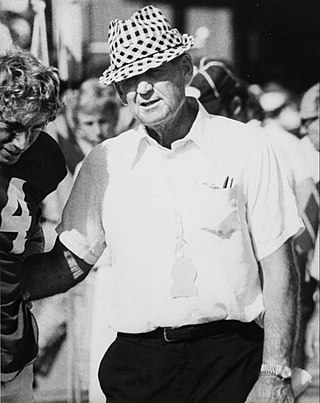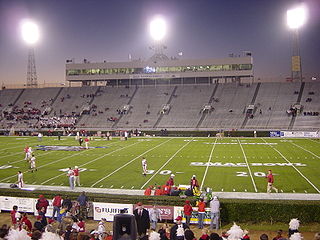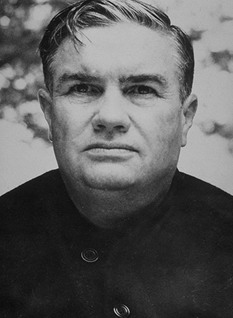
Paul William "Bear" Bryant was an American college football player and coach. He is considered by many to be one of the greatest college football coaches of all time, and best known as the head coach of the University of Alabama football team, the Alabama Crimson Tide, from 1958 to 1982. During his 25-year tenure as Alabama's head coach, he amassed six national championships and 13 conference championships. Upon his retirement in 1982, he held the record for the most wins (323) as a head coach in collegiate football history. The Paul W. Bryant Museum, Paul W. Bryant Hall, Paul W. Bryant Drive, and Bryant–Denny Stadium are all named in his honor at the University of Alabama.

Saban Field at Bryant-Denny Stadium is an outdoor stadium in the southeastern United States, on the campus of the University of Alabama in Tuscaloosa. It is the home field of the Alabama Crimson Tide football team of the Southeastern Conference (SEC).

Ladd–Peebles Stadium is a stadium located in Mobile, Alabama. Opened in 1948, it has a seating capacity of 33,471. It is primarily used for American football, and is the home field for the Senior Bowl, the LendingTree Bowl through the 2020 season, and the University of South Alabama Jaguars through the 2019 season. After the 2019 season, the Jaguars moved to the new on-campus Hancock Whitney Stadium. In addition to football, the stadium is also used for concerts, boxing matches, high school graduations, trade shows, and festivals. Numerous entertainers have performed at Ladd–Peebles Stadium.
The University of Alabama is a school with many traditions. This article describes several of these traditions.

Frank William Thomas was an American football player and coach. He served as the head football coach at the University of Chattanooga from 1925 to 1928 and at the University of Alabama from 1931 to 1946, compiling a career college football record of 141–33–9. During his tenure at Alabama, Thomas amassed a record of 115–24–7 and won four Southeastern Conference titles while his teams allowed an average of just 6.3 points per game. Thomas's 1934 Alabama team completed a 10–0 season with a victory over Stanford in the Rose Bowl and was named national champion by a number of selectors.

Big Al is the costumed elephant mascot of the University of Alabama Crimson Tide in Tuscaloosa, Alabama.

The Alabama Crimson Tide football program represents the University of Alabama in the sport of American football. The team competes in the Football Bowl Subdivision (FBS) of the National Collegiate Athletic Association (NCAA) and the Western Division of the Southeastern Conference (SEC). The team is currently led by Kalen DeBoer. The Crimson Tide is among the most storied and decorated football programs in NCAA history. Since beginning play in 1892, the program claims 18 national championships, including 13 wire-service national titles in the poll-era, and five other titles before the poll-era. From 1958 to 1982, the team was led by Hall of Fame coach Paul "Bear" Bryant, who won six national titles with the program. Alabama then had a dominant run under head coach Nick Saban between 2007 and 2023, resulting in six further national titles.
Johnny Musso is an American former professional football player who was a running back for three seasons with the BC Lions of the Canadian Football League (CFL) and in the National Football League (NFL) with the Chicago Bears. Musso played college football at the University of Alabama, where was a consensus selection on the 1971 College Football All-America Team. He was inducted into the College Football Hall of Fame in 2000.

The Paul W. Bryant Museum is located on the campus of the University of Alabama, in Tuscaloosa, Alabama. Founded in 1985, the museum was opened in 1988 to "house the history of Alabama football, with special emphasis on the legendary coach" Paul William "Bear" Bryant.
Johnny Lee Davis is a former American football running back who played ten seasons in the National Football League (NFL) from 1978 to 1987. Davis was a member of the 1981 San Francisco 49ers team that won Super Bowl XVI. He is a graduate of Sidney Lanier High School in Montgomery, Alabama, and the University of Alabama in Tuscaloosa.
The 1978 Alabama Crimson Tide football team represented the University of Alabama in the 1978 NCAA Division I-A football season. It was the Crimson Tide's 84th overall and 45th season as a member of the Southeastern Conference (SEC). The team was led by head coach Bear Bryant, in his 21st year, and played their home games at Bryant–Denny Stadium in Tuscaloosa and Legion Field in Birmingham, Alabama. They finished season with eleven wins and one loss, as SEC champions and as national champions after a victory over Penn State in the Sugar Bowl. Alabama's costumed "Big Al" mascot officially debuted this season, appearing at the Sugar Bowl.
The 1971 Alabama Crimson Tide football team represented the University of Alabama in the 1971 NCAA University Division football season. It was the Crimson Tide's 77th overall and 38th season as a member of the Southeastern Conference (SEC). The team was led by head coach Bear Bryant, in his 14th year, and played their home games at Denny Stadium in Tuscaloosa and Legion Field in Birmingham, Alabama. They finished season with eleven wins and one loss, as SEC champions and with a loss to Nebraska in the Orange Bowl.
The 1958 Alabama Crimson Tide football team represented the University of Alabama in the 1958 college football season. It was the Crimson Tide's 64th overall and 25th season as a member of the Southeastern Conference (SEC). The team was led by head coach Bear Bryant, in his first year, and played their home games at Denny Stadium in Tuscaloosa, Legion Field in Birmingham and at Ladd Stadium in Mobile, Alabama. They finished with a record of five wins, four losses and one tie. As they finished the season above .500, Alabama secured its first winning season since 1953, and their five victories gave Bryant more wins games in one season than former head coach Jennings B. Whitworth did in previous three.
The 1936 Alabama Crimson Tide football team represented the University of Alabama in the 1936 college football season. It was the Crimson Tide's 43rd overall and 4th season as a member of the Southeastern Conference (SEC). The team was led by head coach Frank Thomas, in his sixth year, and played their home games at Denny Stadium in Tuscaloosa and Legion Field in Birmingham, Alabama. They finished the season with a record of eight wins, zero losses, and one tie.
The 1946 Alabama Crimson Tide football team represented the University of Alabama in the 1946 college football season. It was the Crimson Tide's 52nd overall and 13th season as a member of the Southeastern Conference (SEC). The team was led by head coach Frank Thomas, in his 15th year, and played their home games at Denny Stadium in Tuscaloosa, Legion Field in Birmingham and at the Cramton Bowl in Montgomery. They finished with a record of seven wins and four losses.
Paul Burnum was a coach of multiple sports at the University of Alabama, having served as head coach of the school's men's basketball and baseball teams and an assistant for the football team. He was also the head football coach at Tuscaloosa High School in the university's home city of Tuscaloosa, where he led the Black Bears to an undefeated record, five state championships and a pair of national championships during his five-year tenure there. After his career as a coach ended, Burnum worked in private business and served as a member of the Tuscaloosa City Board of Education. After his death in 1981, Burnum was posthumously inducted into Alabama Sports Hall of Fame.
The Bear Bryant Show was a weekly coaches' show that served as a weekly recap of the Alabama Crimson Tide football team's previous day's game. The show ran during the tenure of head coach Paul "Bear" Bryant from the 1958 through the 1982 seasons. Co-hosted by John Forney (1961–1965), Bill Austin (1966), Charley Thornton (1967–1981) and Steadman Shealy (1982), The Bear Bryant Show was a cultural phenomenon within the state of Alabama that contributed to the rise in popularity and awareness of the university's football program during the 1960s and 1970s. The show ran for an hour during its entire run.
Tommy Wilcox is an American television personality and former college football player. He played defensive back for the University of Alabama Crimson Tide from 1979 through 1982 and was a member of the 1979 national championship team and was a consensus selection to the 1981 College Football All-America Team. Presently Wilcox serves as the host of a hunting and fishing show entitled "Tommy Wilcox Outdoors."







